Abstract
A wide idiotype cross-reactivity was observed among six groups of monoclonal antibodies specific for arsonate and nitrophenyl haptens, hemagglutinin of PR8 and X31 influenza viruses, dextran, A48-idiotype, and a set of six monoclonal antibodies with unknown antigenic specificity. All of these antibodies are encoded by heavy-chain variable region (VH) genes belonging to the J558 VH family. This idiotypic cross-reactivity was determined by studying the binding of these antibodies to a panel of six monoclonal anti-idiotype antibodies, each one raised against a member of the six groups of monoclonal antibodies. The administration at birth of two such monoclonal anti-idiotype antibodies induced a long-lasting suppression not only of the corresponding idiotype but also of VH-related idiotypes with different antigenic specificities. These results suggest that the idiotypes encoded by VH genes that belong to the same VH gene family are interactive one with another. The possible physiological consequences of this immunochemical cross-reactivity are discussed.
Full text
PDF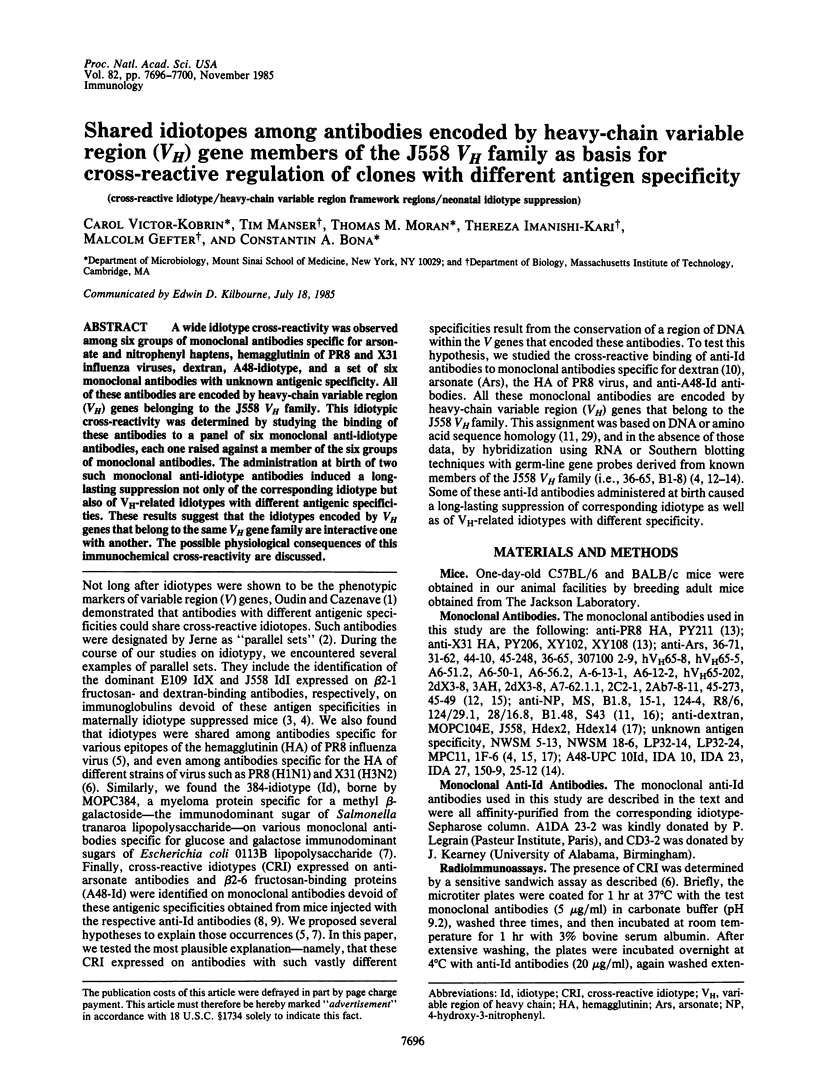
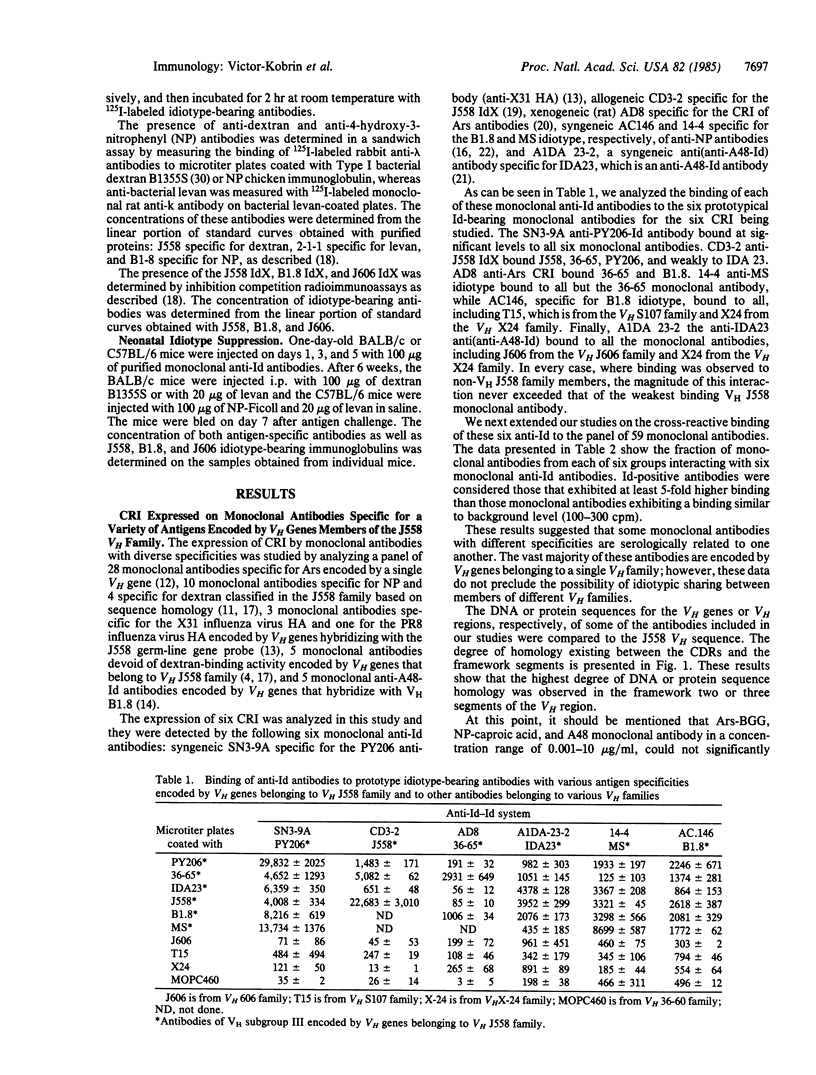
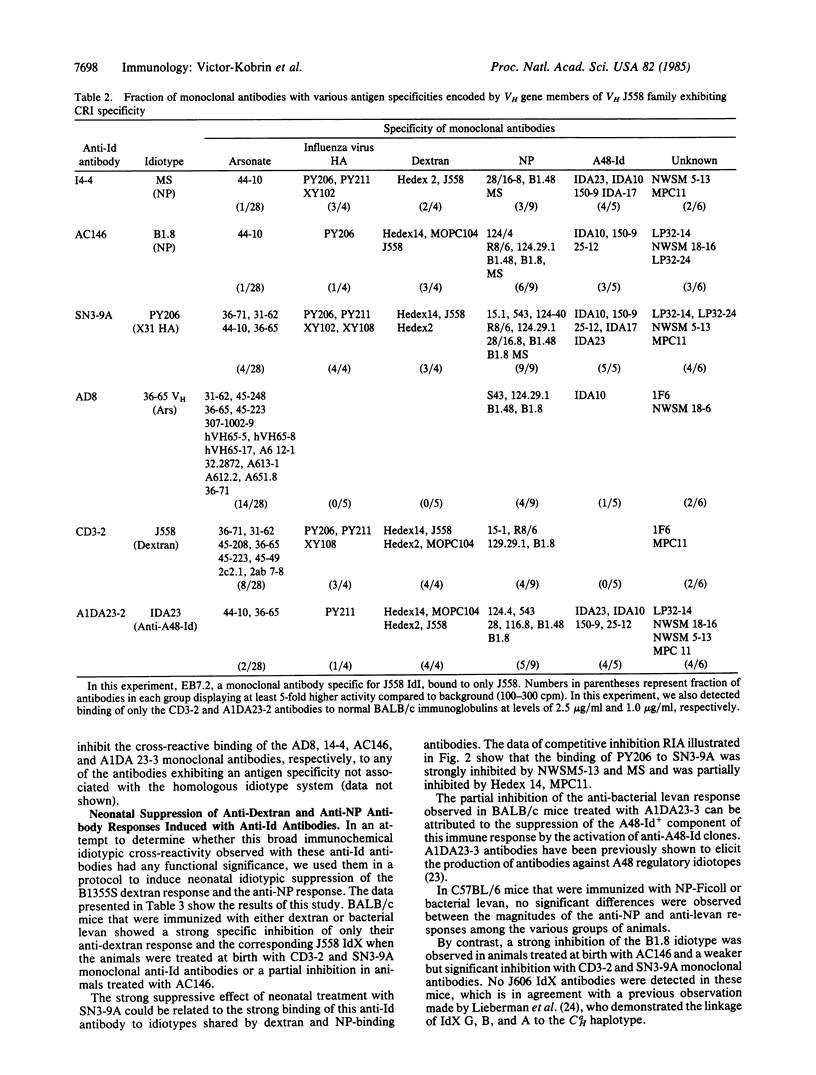
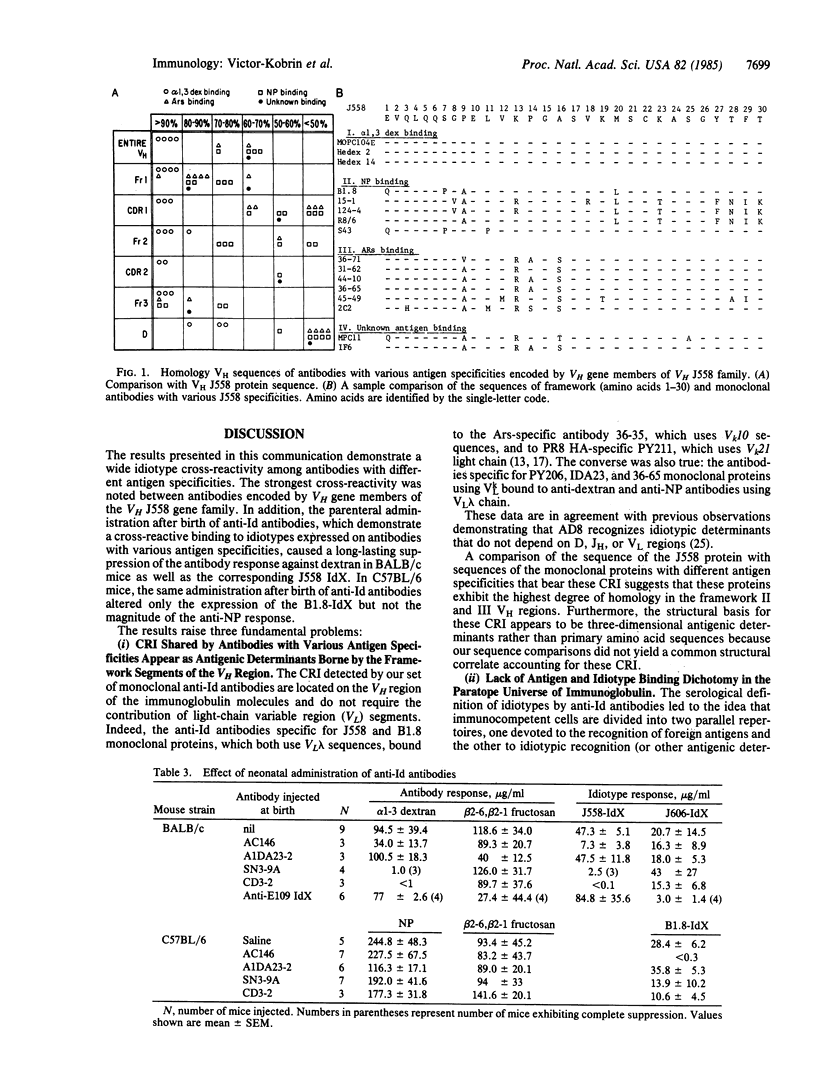
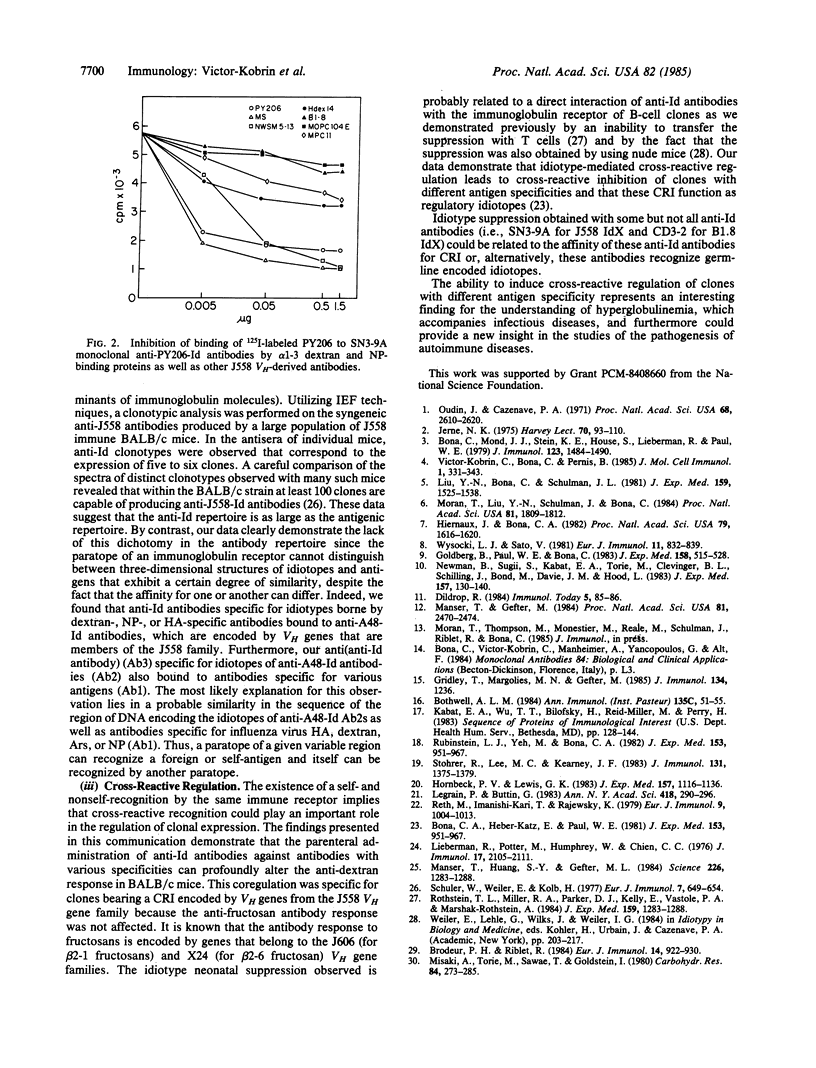
Selected References
These references are in PubMed. This may not be the complete list of references from this article.
- Bona C. A., Heber-Katz E., Paul W. E. Idiotype-anti-idiotype regulation. I. Immunization with a levan-binding myeloma protein leads to the appearance of auto-anti-(anti-idiotype) antibodies and to the activation of silent clones. J Exp Med. 1981 Apr 1;153(4):951–967. doi: 10.1084/jem.153.4.951. [DOI] [PMC free article] [PubMed] [Google Scholar]
- Bona C., Mond J. J., Stein K. E., House S., Lieberman R., Paul W. E. Immune response to levan. III. The capacity to produce anti-inulin antibodies and cross-reactive idiotypes appears late in ontogeny. J Immunol. 1979 Oct;123(4):1484–1490. [PubMed] [Google Scholar]
- Bothwell A. L. Idiotypic inheritance: allelic relationships between immunoglobin genes. Ann Immunol (Paris) 1984 Jan-Feb;135C(1):51–55. doi: 10.1016/s0769-2625(84)80011-2. [DOI] [PubMed] [Google Scholar]
- Brodeur P. H., Riblet R. The immunoglobulin heavy chain variable region (Igh-V) locus in the mouse. I. One hundred Igh-V genes comprise seven families of homologous genes. Eur J Immunol. 1984 Oct;14(10):922–930. doi: 10.1002/eji.1830141012. [DOI] [PubMed] [Google Scholar]
- Goldberg B., Paul W. E., Bona C. A. Idiotype-antiidiotype regulation. IV. Expression of common regulatory idiotopes on fructosan-binding and non-fructosan-binding monoclonal immunoglobulin. J Exp Med. 1983 Aug 1;158(2):515–528. doi: 10.1084/jem.158.2.515. [DOI] [PMC free article] [PubMed] [Google Scholar]
- Gridley T., Margolies M. N., Gefter M. L. The association of various D elements with a single-immunoglobulin VH gene segment: influence on the expression of a major cross-reactive idiotype. J Immunol. 1985 Feb;134(2):1236–1244. [PubMed] [Google Scholar]
- Hiernaux J., Bona C. A. Shared idiotypes among monoclonal antibodies specific for different immunodominant sugars of lipopolysaccharide of different Gram-negative bacteria. Proc Natl Acad Sci U S A. 1982 Mar;79(5):1616–1620. doi: 10.1073/pnas.79.5.1616. [DOI] [PMC free article] [PubMed] [Google Scholar]
- Hornbeck P. V., Lewis G. K. Idiotype connectance in the immune system. I. Expression of a cross-reactive idiotype on induced anti-p-azophenylarsonate antibodies and on endogenous antibodies not specific for arsonate. J Exp Med. 1983 Apr 1;157(4):1116–1136. doi: 10.1084/jem.157.4.1116. [DOI] [PMC free article] [PubMed] [Google Scholar]
- Jerne N. K. The immune system: a web of V-domains. Harvey Lect. 1974 1975;70(SERIES):93–110. [PubMed] [Google Scholar]
- Legrain P., Buttin G. The level of expression and the molecular distribution of ABPC 48 idiotopes in levan- or anti-idiotope-primed BALB/c mice. Ann N Y Acad Sci. 1983;418:290–295. doi: 10.1111/j.1749-6632.1983.tb18077.x. [DOI] [PubMed] [Google Scholar]
- Lieberman R., Potter M., Humphrey W., Jr, Chien C. C. Idiotype of inulin-binding antibodies and myeloma proteins controlled by genes linked to the allotype locus of the mouse. J Immunol. 1976 Dec;117(6):2105–2111. [PubMed] [Google Scholar]
- Liu Y. N., Bona C. A., Schulman J. L. Idiotypy of clonal responses to influenza virus hemagglutinin. J Exp Med. 1981 Nov 1;154(5):1525–1538. doi: 10.1084/jem.154.5.1525. [DOI] [PMC free article] [PubMed] [Google Scholar]
- Manser T., Gefter M. L. Isolation of hybridomas expressing a specific heavy chain variable region gene segment by using a screening technique that detects mRNA sequences in whole cell lysates. Proc Natl Acad Sci U S A. 1984 Apr;81(8):2470–2474. doi: 10.1073/pnas.81.8.2470. [DOI] [PMC free article] [PubMed] [Google Scholar]
- Manser T., Huang S. Y., Gefter M. L. Influence of clonal selection on the expression of immunoglobulin variable region genes. Science. 1984 Dec 14;226(4680):1283–1288. doi: 10.1126/science.6334361. [DOI] [PubMed] [Google Scholar]
- Moran T., Liu Y. C., Schulman J. L., Bona C. A. Shared idiotopes among monoclonal antibodies specific for A/PR/8/34 (H1N1) and X-31(H3N2) influenza viruses. Proc Natl Acad Sci U S A. 1984 Mar;81(6):1809–1812. doi: 10.1073/pnas.81.6.1809. [DOI] [PMC free article] [PubMed] [Google Scholar]
- Newman B., Sugii S., Kabat E. A., Torii M., Clevinger B. L., Schilling J., Bond M., Davie J. M., Hood L. Combining site specificities of mouse hybridoma antibodies to dextran B1355S. J Exp Med. 1983 Jan 1;157(1):130–140. doi: 10.1084/jem.157.1.130. [DOI] [PMC free article] [PubMed] [Google Scholar]
- Oudin J., Cazenave P. A. Similar idiotypic specificities in immunoglobulin fractions with different antibody functions or even without detectable antibody function. Proc Natl Acad Sci U S A. 1971 Oct;68(10):2616–2620. doi: 10.1073/pnas.68.10.2616. [DOI] [PMC free article] [PubMed] [Google Scholar]
- Reth M., Imanishi-Kari T., Rajewsky K. Analysis of the repertoire of anti-(4-hydroxy-3-nitrophenyl)acetyl (NP) antibodies in C 57 BL/6 mice by cell fusion. II. Characterization of idiotopes by monoclonal anti-idiotope antibodies. Eur J Immunol. 1979 Dec;9(12):1004–1013. doi: 10.1002/eji.1830091216. [DOI] [PubMed] [Google Scholar]
- Rothstein T. L., Miller R. A., Parker D. J., Kelly E., Vastola A. P., Marshak-Rothstein A. Induction of idiotope suppression in the anti-azophenylarsonate response of T-depleted A/J mice. J Exp Med. 1984 Apr 1;159(4):1283–1288. doi: 10.1084/jem.159.4.1283. [DOI] [PMC free article] [PubMed] [Google Scholar]
- Schuler W., Weiler E., Kolb H. Characterization of syngeneic anti-idiotypic antibody against the idiotype fo BALB/c myeloma protein J558. Eur J Immunol. 1977 Sep;7(9):649–654. doi: 10.1002/eji.1830070914. [DOI] [PubMed] [Google Scholar]
- Stohrer R., Lee M. C., Kearney J. F. Analysis of the anti-alpha 1 leads to 3 dextran response with monoclonal anti-idiotype antibodies. J Immunol. 1983 Sep;131(3):1375–1379. [PubMed] [Google Scholar]
- Victor-Kobrin C., Bona C., Pernis B. Expansion of idiotype positive B cells in maternally idiotype suppressed mice. J Mol Cell Immunol. 1984;1(6):331–346. [PubMed] [Google Scholar]
- Wysocki L. J., Sato V. L. The strain A anti-p-azophenylarsonate major cross-reactive idiotypic family includes members with no reactivity toward p-azophenylarsonate. Eur J Immunol. 1981 Oct;11(10):832–839. doi: 10.1002/eji.1830111016. [DOI] [PubMed] [Google Scholar]


